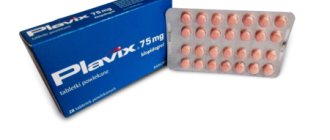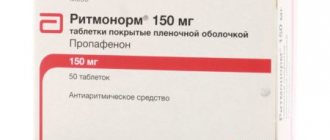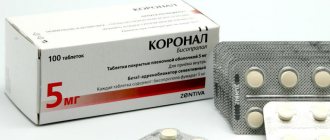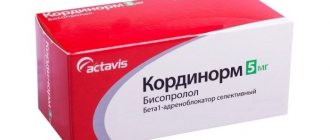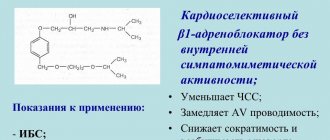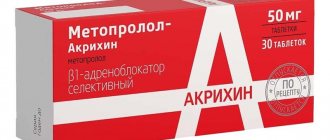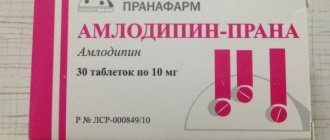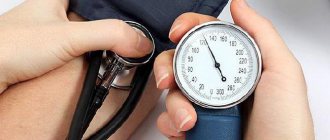Side effects
The use of the drug Amiodarone can cause the following side effects: hypotension, tachycardia, progression of arrhythmia and chronic heart failure, cough, shortness of breath, alveolitis, pleurisy, interstitial pneumonia, pulmonary fibrosis, bronchospasm, apnea, toxic hepatitis, cirrhosis of the liver, jaundice, cholestasis, hemolytic and aplastic anemia.
When administered intramuscularly or intravenously, it can cause an increase in intracranial pressure.
Sometimes causes paresthesia, weakness, depression, tremor, headaches, dizziness, ataxia, auditory hallucinations, sleep disturbance, optic neuritis, memory impairment, uveitis, sinus bradycardia, thyrotoxicosis, hypothyroidism, loss of appetite, nausea, changes in taste sensations, pain and heaviness in the epigastrium, diarrhea, flatulence, constipation, exfoliative dermatitis, deterioration of potency, rash, alopecia, myopathy, vasculitis, fever, increased sweating, change in skin color.
Instructions for use of Amiodarone side effects
Negative effects from taking medication are quite common. According to medical statistics, the most common among them are:
- changes in the normal production of hormones in the thyroid gland, hypo- and hyperthyroidism - up to 10% of patients;
- inflammation of the esophageal mucosa, liver damage – 4-25% of patients;
- neurological abnormalities, headache, tremors in the limbs – 20-40%;
- amiodarone-induced pulmonary toxicity (AIPT) – 5-17% of patients.
The last of the listed side effects of Amiodarone is the most dangerous, since in 5-20% of cases it leads to death. The forms and symptoms of this disease are described below.
Other possible complications that are noted in the instructions for Amiodarone 200 mg are the following:
- neuritis and optic neuropathy, accompanied by decreased visual function;
- the formation of lipid deposits in the cornea, manifested in the appearance of a halo or blurred contours of visual objects;
- dermatopathies - coloring of the skin in a gray-blue color, peeling, redness and inflammation, rash, depigmentation, hair loss, photosensitivity (excessive reaction to solar radiation);
- bradycardia (heart contractions less than 60 per minute);
- increased arrhythmia;
- tachycardia;
- increased signs of chronic heart failure;
- nausea, vomiting, metallic taste in the mouth, constipation, diarrhea, flatulence;
- toxic hepatitis accompanied by jaundice, liver failure;
- feeling of heaviness in the stomach;
- thrombocytopenia;
- syndrome of inadequate vasopressin production, manifested in edema and decreased daily urine volume;
- sleep and memory disturbances; delirium;
- inflammation of the epididymis, impotence;
- limitation of motor activity as a result of myopathy;
- impaired motor skills and coordination resulting from damage to the cerebellum;
- inflammation of blood vessels;
- hemolytic anemia.
If these side effects and other symptoms occur, you should stop taking the drug and consult a doctor. In many cases, reducing the dose or stopping the medication completely will reverse these changes in the patient's condition.
pharmachologic effect
According to its pharmacological effects, Amiodarone 200 mg is one of the drugs that are used to interrupt and prevent attacks of angina pectoris, which is the most common form of coronary heart disease. The medicine is also prescribed for other pathological conditions when coronary blood flow is impaired.
The therapeutic effect is associated with the ability of the active substance to increase the duration of fluctuations in the membrane potential of the muscle cells of the heart, as well as change other parameters of this organ:
- the duration of the cardiac cycle in which the myocardium is not excited (without this period the pumping activity of the heart is impossible);
- the speed of the conduction signal in the atrioventricular node, which is the secondary center of cardiac stimulation;
- excitation of the His bundle - the conduction system responsible for the transmission of nerve impulses through the myocardium.
As a result, the automaticity of the sinus node, which underlies arrhythmia, decreases. This mechanism when using Amiodarone is associated with the following effects:
- blockade of potassium channels (decreasing the intensity of the excretion of potassium ions from the muscle cells of the heart);
- coronary effect, reducing the tone of the coronary vessels;
- reducing myocardial oxygen demand, increasing energy reserves;
- inhibition of the transmission of nerve impulses, decreased sensitivity to stimulation of the sympathetic nervous system;
- decrease in blood pressure (with intravenous administration).
Composition and effect of the drug, its release form
The main active ingredient of the drug is amiodarone. This substance is included in the pharmacological group of class III antiarrhythmic drugs and its main effect is aimed at suppressing arrhythmia. The mechanism of action of amiodarone is to reduce the need of the heart muscle for oxygen, but with an increase in its supply to the tissue due to the dilation of the heart vessels. In addition, amiodarone reduces heart rate, and by acting on adrenal and calcium receptors it can reduce blood pressure, especially when administered intravenously.
Enter your pressure
Move the sliders
120
on
80
The drug "Amiodarone" is produced in tablet form and as an injection solution. Tablets are produced in a dosage of 200 mg (0.2 g). The package contains 30 or 60 tablets. The solution for injection is produced in ampoules of 3 ml at a concentration of 5% (150 mg in each ampoule).
Thyroid pathologies
Side effects associated with dysfunction of the thyroid gland are most often observed in those patients who already had dysfunction of this organ before taking Amiodarone. 10% of the iodine contained in the preparation is in a free state. Bound iodine also affects hormone metabolism. As a result, the following deviations may develop:
- hypothyroidism (persistent lack of thyroid hormones);
- hyperthyroidism (excess of its hormones);
- thyrotoxicosis (intoxication with thyroid hormones).
The second condition often leads to atrial fibrillation, tachycardia and increased arrhythmia. If the above pathologies are detected, Amiodarone should be discontinued. Abnormal changes in the thyroid gland to varying degrees are found in up to half of patients taking this drug.
Treatment of thyrotoxicosis is carried out with the help of glucocorticoids, Thiamazole, potassium perchlorate. In severe cases, patients undergo removal of the thyroid gland.
What are the side effects?
When the drug is taken correctly and for a short period of time, it practically does not cause any negative effects, but if the patient is allergic to its components or “Amidarone” was taken for a period exceeding the permissible norms, the following reactions of the body may occur:
Some people may experience baldness from the drug.
- hepatitis;
- myopathy and neuropathy;
- the appearance of blue and gray spots on the body;
- corneal microdeposits;
- dysfunction of the thyroid gland;
- pulmonary fibrosis;
- dyspnea;
- insomnia;
- nausea;
- baldness;
- tachycardia;
- photosensitivity;
- tremor of the limbs;
- blood pressure problems;
- abdominal pain;
- constipation;
- hives;
- thrombophlebitis;
- bronchospasm;
- apnea;
- loss of appetite;
- loss of taste.
Pharmacological mechanism of action of the drug
Amiodarone is characterized by antiarrhythmic and antianginal properties; analogues in some cases can replace it. Its antiarrhythmic effect is based on reducing the currents of potassium ions when exposed to cell membranes - cardiomyocytes. Causes a decrease in the sinus node, which forms bradycardia.
The use of the drug "Amiodarone" (tablets) allows you to increase the refractory segment of the conduction mechanism of the heart. Inhibits conduction along secondary pathways in patients with severe Wolff-Parkinson-White syndrome. In turn, the antianginal effect of the drug is based on reducing myocardial oxygen consumption and reducing its effect on arterial muscles. It contains iodine, which, when consumed, changes the quantitative content of thyroid hormones, as a result of which the degree of their effect on the myocardium is reduced.
Amiodarone has a cumulative effect, and a pronounced effect from its use occurs only after a week of regular use of the drug, and the maximum is achieved after two to three weeks.
About 40% of the drug dose taken is absorbed internally, Cmax in plasma appears after 3–7 hours. The effect can last for several weeks. Metabolic processes occur mainly in the liver, where the active element desethylamiodarone is formed, which is the main metabolite. Excreted in excreted bile and urine, T1/2 - after a single dose of the drug 3.2–20.7 hours, with long-term therapy - after 53±24 days.
Amiodarone, 50 mg/ml, concentrate for solution for intravenous administration, 3 ml, 10 pcs.
Intravenous bolus administration of the drug Amiodarone is usually not recommended due to hemodynamic risks (development of a pronounced decrease in blood pressure, vascular collapse); intravenous drip administration of the drug is preferable.
Intravenous jet administration of the drug Amiodarone should be carried out only in the intensive care unit with constant monitoring of ECG (due to the possibility of developing excessive bradycardia and arrhythmogenic effects) and blood pressure (due to the possibility of lowering blood pressure).
In order to avoid reactions at the injection site, it is recommended that Amiodarone be administered through a central venous catheter. Only in the case of cardiac resuscitation for cardiac arrest caused by ventricular fibrillation resistant to defibrillation, in the absence of central venous access (no central venous catheter in place), Amiodarone can be administered into a large peripheral vein with maximum blood flow. If it is necessary to continue treatment with Amiodarone after cardiac resuscitation, Amiodarone should be administered intravenously through a central venous catheter under constant monitoring of blood pressure and ECG.
Amiodarone should not be mixed in the same syringe or dropper with other medications. Do not administer other drugs into the same infusion line as Amiodarone.
Cardiac reactions
The occurrence of new rhythm disturbances or worsening of existing rhythm disturbances, sometimes with fatal outcome, has been reported. It is very important to make a differential diagnosis between the insufficient effectiveness of the drug and its arrhythmogenic effect, whether combined or not with an aggravation of the severity of cardiovascular pathology. Arrhythmogenic effects have been reported significantly less frequently with Amiodarone than with other antiarrhythmic drugs and have generally been observed in the presence of factors that prolong the QT interval, such as drug interactions and/or electrolyte disturbances. Despite the ability of Amiodarone to prolong the QT interval, it has shown low activity in provoking torsade de pointes (TdP).
Severe bradycardia.
When Amiodarone was used in combination with sofosbuvir in combination with other direct-acting antiviral drugs against viral hepatitis C, such as daclatasvir, simeprevir, ledipasvir, cases of severe, potentially life-threatening bradycardia, as well as heart block, were observed. Therefore, the simultaneous use of these drugs with Amiodarone is not recommended.
If concomitant use of these drugs with Amiodarone cannot be avoided, close monitoring of patients is recommended after initiating sofosbuvir in combination with other direct-acting antivirals. After starting concomitant use of sofosbuvir, patients who are at high risk of developing bradyarrhythmias should be monitored continuously in a hospital setting for at least 48 hours.
Due to the long half-life of amiodarone, appropriate monitoring should also be performed in patients who have stopped taking amiodarone within the last few months before starting treatment with sofosbuvir in combination with other direct acting antivirals.
Patients taking the above drugs against hepatitis C virus in combination with Amiodarone, either simultaneously with other drugs that slow the heart rate or without combination with such drugs, should be informed about symptoms indicating the development of bradycardia and heart block. If they occur, they should seek medical attention immediately.
Pulmonary disorders
The appearance of shortness of breath or dry cough may be associated with pulmonary toxicity, in particular the development of interstitial pneumonitis. In very rare cases, the development of interstitial pneumonitis has been observed after intravenous administration of the drug Amiodarone. If the development of interstitial pneumonitis is suspected in patients who experience severe shortness of breath, either isolated or in combination with a deterioration in general condition (fatigue, weight loss, fever), an X-ray examination of the lungs should be performed. The need for Amiodarone should be re-evaluated as interstitial pneumonitis is usually reversible if the drug is discontinued early (clinical symptoms usually resolve within 3-4 weeks, followed by a slower improvement in radiographic findings and pulmonary function over several months). Treatment with glucocorticosteroids should be considered.
In addition, in very rare cases, usually immediately after surgery, a serious respiratory complication (adult acute respiratory distress syndrome), sometimes fatal, has been observed in patients treated with amiodarone; the possibility of a connection between its development and interaction with high oxygen concentrations is assumed.
Liver disorders
Careful monitoring of liver function tests (monitoring the activity of liver transaminases) is recommended before starting the use of Amiodarone and regularly during treatment with the drug. During the first 24 hours after intravenous administration of Amiodarone, acute liver damage (including hepatocellular failure or liver failure, sometimes fatal) and chronic liver damage may occur. Therefore, if the activity of “liver” transaminases increases, 3 times higher than the upper limit of normal, the dose of Amiodarone should be reduced or discontinued.
Clinical and laboratory signs of chronic liver failure when using the drug Amiodarone orally can be minimally expressed (hepatomegaly, increased transaminase activity 5 times the upper limit of normal) and reversible after discontinuation of the drug, but cases of death have been reported.
Severe bullous reactions
Treatment with Amiodarone should be stopped immediately if symptoms and manifestations of life-threatening or even fatal reactions such as Stevens-Johnson syndrome, toxic epidermal necrolysis appear, namely the appearance of a progressive skin rash, often with blistering, or the appearance of damage to the mucous membranes.
Visual disorders
If decreased visual acuity or blurred vision occurs, a complete ophthalmological examination, including funduscopy (examination of the fundus of the eye), should be immediately performed. The manifestation of neuropathy and/or optic neuritis requires discontinuation of amiodarone due to the possible development of blindness.
Drug interactions
The simultaneous use of Amiodarone with the following drugs is not recommended: beta-blockers, blockers of “slow” calcium channels, slowing heart rate (verapamil, diltiazem), laxatives, stimulating intestinal motility, which can cause hypokalemia.
Hypokalemia
Hypokalemia should be corrected before starting Amiodarone.
Children
The safety and effectiveness of Amiodarone have not been studied in children. Amiodarone ampoules contain benzyl alcohol. Severe choking with fatal outcome has been reported in newborns after intravenous administration of solutions containing benzyl alcohol. Symptoms of the development of this complication are: acute development of suffocation, decreased blood pressure, bradycardia and collapse.
General and local anesthesia
Before surgery, the anesthesiologist should be informed that the patient has been administered the drug Amiodarone. Treatment with Amiodarone may increase the hemodynamic risk inherent in local or general anesthesia (in particular, slowing of heart rate, slowing of conduction and decreased contractility of the heart.)
Thyroid dysfunction
Amiodarone may cause thyroid dysfunction, especially in patients with a personal or family history of thyroid dysfunction. Therefore, in the case of a transition from internal administration of the drug Amiodarone to oral administration of the drug Amiodarone, both during treatment and for several months after the end of treatment, careful clinical and laboratory monitoring of thyroid function should be carried out. If thyroid dysfunction is suspected, serum TSH concentrations should be determined (using an ultrasensitive TSH test).
The drug Amiodarone contains iodine and therefore can interfere with the absorption of radioactive iodine, which can distort the results of a radioisotope study of the thyroid gland, but its use does not affect the reliability of determining the concentrations of T3, T4 and TSH in the blood plasma.
Impact on the ability to drive vehicles and machinery
There is no evidence that amiodarone impairs the ability to engage in activities requiring increased concentration and psychomotor speed. However, as a precaution, it is advisable for patients with paroxysms of severe arrhythmias to refrain from such activities during treatment with Amiodarone.
What does this medicine help with?
Many patients with cardiac arrhythmia are prescribed Amiodarone tablets. What this medication is for is the first question from patients. Amiodarone tablets help normalize heart rhythm, thus eliminating the threat to human life. Since it belongs to class III drugs, Amiodarone lengthens the refractory period of the atria and ventricles. Thus, the contraction-activation mechanism of the heart muscle occurs stably, without disturbing the correct rhythm.
The instructions for use of Amiodarone tablets note that the antianginal effect of the drug is to eliminate the symptoms of myocardial ischemia in people suffering from coronary heart disease.
Causes of arrhythmia
Composition and release form
The main active ingredient is amiodarone hydrochloride. It blocks potassium and calcium channels of cardiomycytes and, thus, inhibition of adrenergic receptors occurs. This increases the duration of potential action of cardiac tissue. Blockade of the channels leads to the fact that the myocardial oxygen demand decreases, and this slows down conduction and at the same time makes the refractory period in the sinus node longer. Thanks to all these actions, the drug has antiarrhythmic and antianginal effects. Each Amiodarone ampoule contains the active substance, and in addition to it - sodium acetate, acetic acid, benzyl alcohol, water and acetate trihydrate. The additional components in the tablet form of Amiodarone are:
- corn starch;
- silica;
- magnesium stearate;
- lactose;
- croscarmellose sodium.
Pharmacokinetics
This drug is characterized by complex pharmacokinetics. This is due to the following factors:
- very high degree of affinity for fats;
- large volume of distribution in the human body;
- prolonged therapeutic effect;
- delayed action when taken orally;
- long period of elimination from the body.
The amount of the active substance of the tablets reaching the heart tissue ranges from 22-86% (on average this value is 50%). When taken with food, bioavailability increases. The therapeutic concentration in the blood is 0.5-2.5 mg/ml. With a higher content of Amiodarone, side effects occur more often. After stopping treatment on days 3-10, its amount in the blood decreases by half. However, the true half-life (time required to lose 50% of pharmacological activity) can be as long as 142 days. After the end of administration, the active substance is detected in the blood for up to 9 months.
Decomposition of Amiodarone 200 mg occurs in the liver. Metabolites (desethylamiodarone and others) are mainly excreted in bile and feces, and only a small amount is excreted through the kidneys in the urine (up to 1% of the total dose). Absorption in the gastrointestinal tract, according to various estimates, is 20-55%. The active substance accumulates in fatty tissues and organs that are characterized by a high level of blood supply (lungs, skin, spleen, liver), actively binding to proteins. When it decomposes, iodine is also released, the amount of which can reach 80% of the concentration of the drug.
According to the instructions for use of Amiodarone 200 mg, the medicine is able to penetrate the placenta of a pregnant woman (up to half of the absorbed amount). The drug is also excreted in mother's breast milk (up to a quarter of the dose).
Directions for use and dosage
Amiodarone injection solution is administered intravenously, the dosage of the drug for acute rhythm disturbances is 5 mg per 1 kg of the patient’s body weight, for CHF it is halved.
Amiodarone tablets are taken orally, depending on the indications, before, during or after meals, with a small amount of liquid and without chewing. The dosage of the drug is 0.6-0.8 g three times a day, after 5-15 days the dose is reduced to 0.4 g per day, then the patient is transferred to maintenance therapy - 0.2-0.3 g of the drug, divided into 1-2 doses per day. It is recommended to avoid accumulation after five days of taking the drug, to take a break for two days, or after a three-week course not to take Amiodarone for a week.
In cases of angina pectoris, 0.2 g of the drug is prescribed three times a day, after two weeks the dose is reduced to a single dose of 0.2 g of the drug per day.
Special Recommendations
Therapeutic treatment with Amiodarone should be carefully monitored by a physician. The instructions for use of the tablet recommend using it after an X-ray examination of the liver, lungs and an electrocardiogram. Similar monitoring should be carried out in the future if the patient continues to take the medicine.
The severity of side effects often directly depends on the dose the patient takes. You should try to use the drug as rarely and in minimal quantities as possible. Quitting the drug Amiodarone often causes heart rhythm disturbances.
Instructions for use - reviews say that, despite the side effects, this drug has saved more than one life - states that the pharmacological effect of the drug persists for another two weeks after its discontinuation.
The tablets contain iodine, which helps build up levels of radioactive iodine in the thyroid gland. Therefore, at the beginning of therapeutic treatment, during the process and at the end, you need to constantly take tests for the amount of thyroid hormones.
During therapeutic treatment, it is necessary to avoid prolonged exposure to the sun; do not take open sunbathing
The drug should be administered with particular caution to the elderly, under general anesthesia or during a course of oxygen treatment. It should be used with caution by drivers and persons whose profession involves a special concentration of attention.
In cases of overdose, aggravation of side effects, as well as hypotension and arrhythmia, may occur. Bradycardia or disruption of AV conduction may occur. Excess can lead to liver dysfunction.
In this case, immediate gastric lavage is recommended, activated charcoal is prescribed, and saline laxative solutions are recommended. For bradycardia, atropine injections are given, beta-adrenergic receptor agonists are used, and cardiac stimulation is performed.
Indications and use
An antiarrhythmic drug that is often used in hospitals due to its low cost and effectiveness. Amiodarone can be prescribed for most types of ventricular and supraventricular arrhythmias. In the hospital, to begin with, a loading dose is administered intravenously slowly and only dropwise (through a dropper), followed by a maintenance dose. If necessary, extend the course of treatment, tablets may be prescribed. The tablets are taken before meals (30 minutes) with a glass of water. Due to the danger of self-administration of the drug, I do not indicate the dose. The dose is selected by the attending physician under ECG monitoring; sometimes Holter ECG monitoring (24 hours) may be required; be sure to indicate the time you took amiodarone in your diary.
Dosages and timing of amiodarone use
Onset of action of the drug
significantly shifted in time. When taken orally, the effect begins to appear on the 3-7th day of treatment, and it may take up to 50 days for the maximum effect to develop. If necessary, the speed of onset of action can be increased by prescribing the drug in very high doses (for example, 600-1200 mg/day) for 1-2 weeks. Then the dose should be reduced to 400 mg/day.
After achieving the antiarrhythmic effect
It is recommended to gradually reduce the dose of the drug until the minimum effective dose is determined. Typically the maintenance dose is 200-400 mg/day. For some patients, taking 200 mg every other day is sufficient. In the author's experience, when the daily dose in adults is reduced to less than 300 mg/day. relapses of arrhythmia usually recur. In case of dangerous forms of arrhythmia, you should not take risks and reduce the dose of the drug below 300 mg/day.
A drug
undergoes metabolism in the liver; not excreted by the kidneys. The main metabolite is desethylamiodarone, which itself has an antiarrhythmic effect. Very high concentrations of amiodarone and its metabolite are observed in the lungs, heart, liver and adipose tissue.
When administered intravenously, the effect
develops more quickly than when taken orally, however, unlike most other drugs, immediate antiarrhythmic effect is rarely observed. It usually develops within 1-24 hours. If the arrhythmia is difficult to treat, intravenous amiodarone may be appropriate (despite a possible delay in onset of action) rather than trying other drugs that are less effective and often cause side effects.
Recommended dose for intravenous administration
is 5 mg/kg over 30-60 minutes, followed by an infusion of 15 mg/kg over 24 hours. In emergency situations, initial intravenous administration can be carried out at a faster rate, however, the vasodilating effect of amiodarone can lead to the development of severe arterial hypotension. To avoid the development of phlebitis, the drug should be administered through a central vein. If this is not possible, it is recommended to change infusion sites more frequently (this is usually sufficient).
— We also recommend “
Dronedarone for cardiac arrhythmia - indications, contraindications"
- Contraindications for antiarrhythmic drugs
- Medication options for treating cardiac arrhythmias (classification)
- Flecainide for arrhythmia - indications, contraindications
- Propafenone for cardiac arrhythmia - indications
- Amiodarone for cardiac arrhythmia - indications, contraindications
- Dronedarone for cardiac arrhythmia - indications, contraindications
- Dofetilide for cardiac arrhythmia - indications, contraindications
- Vernakalant for cardiac arrhythmia - indications, contraindications
- Adenosine for cardiac arrhythmia - indications, contraindications
- Verapamil for cardiac arrhythmia - indications, contraindications
How to use
Since Amiodarone comes in several forms, the methods of administration vary. The tablets are taken orally with water at room temperature. It can be taken with food or immediately after it; the dosage is determined by the specialist personally and depends on the patient’s well-being.
The loading dose for therapy in hospital settings is 600-800 mg/d in several doses until a total dose of 10 mg is obtained, which is usually achieved within 5-8 days of therapy. For outpatient therapy, the dosage is 600-800 mg/d in several doses up to a total dose of 10 g, achieved in one and a half to two weeks.
The maintenance dose is equal to 100-400 mg or? - 2 tablets per day. If a long course of therapy is expected, then you can take Amiodarone not every day, but with a break of 1-2 days, for example, take tablets for 5 days, and then take a 2-day break.
When treating elderly patients, it is necessary to adjust the dose downwards.
Amiodarone injections are given intravenously. Due to the characteristics of the dosage form of the drug, it is prohibited to use a concentration of less than 500 ml per 2 ampoules.
For dilution, only an isotonic glucose solution is used; other drugs cannot be added.
Amiodarone is injected into a central vein. But sometimes injection into peripheral veins is possible if cardiopulmonary resuscitation is performed during myocardial arrest in the absence of central venous access. The initial dosage into the central vein is 5 mg/kg, administered by infusion over 20-120 minutes. It is allowed to repeat infusions up to 2-3 times a day.
[media=
https://youtu.be/7xxO3T7j1Ss
]
Maintenance therapy is carried out at a dosage of 10-20 mg/d per 250 ml of glucose solution. In this case, from the first day of therapy, they begin to gradually switch to induced oral intake of 3 tablets per 24 hours. If necessary, the dose is increased to 5 tablets per day.
Adverse reactions
In the description, I highlight the most frequent ones, but any reactions are possible; if your condition changes, be sure to inform your doctor about it.
All types of allergic reactions to the drug and excipients.
Bradycardia, deterioration of conduction, worsening of existing arrhythmias.
Nausea, vomiting, taste disturbance.
Liver disorders and increased liver transaminases in the blood.
Lungs: shortness of breath, dry cough - require x-ray examination, discontinuation of the drug is possible.
Rarely, visual impairment occurs in the form of the appearance of colored areas or blurred contours.
Thyroid gland: hypothyroidism, hyperthyroidism are quite common side effects.
Increased sensitivity to sunlight (photosensitivity) may occur.
Nervous system: hand tremor (shaking), sleep disturbance, nightmares.
Pharmacological group
Amiodarone is prescribed for cardiac arrhythmias. The drug group is class III antiarrhythmic drugs.
As you know, the human heart must contract in a certain rhythm. It is provided by a system of nodes, bundles of nerve fibers located in the myocardium. It is there that impulses in cardiac activity are generated and their implementation takes place.
When disorders occur, disruptions occur in the rhythm of contractions, they either become more frequent (tachycardia) or occur intermittently longer than usual (bradycardia).
In some cases, disturbances in the rhythm of the heart muscle cause a person to feel sick, feel tired, and faint. Cases of sudden arrhythmic death are also common.
Features of the drug
The presented drug among antiarrhythmic medications has established itself as one of the best
The use of this drug should be used with caution given the many adverse reactions it may cause. For a long time, cardiologists considered this medicine a “last resort”
A number of studies have established that this drug not only has the characteristics of the most effective medicine, but compared to drugs of a similar type it is the safest. Observations, as well as the study of statistical information, have revealed that the use of Amiodarone leads to a decrease in the mortality rate, including sudden deaths.
An arrhythmogenic effect while taking this medication was observed in one percent of patients, which is a minimal number compared to other drugs. Specialists prescribe Amiodarone if there are appropriate indications. This remedy is prescribed to patients even if they have organic heart damage.
Use of amiodarone in patients with atrial fibrillation
According to the recommendations of experts of the American College of Cardiology, the American Heart Association and the European Society of Cardiology (ACC/AHA/ESC) from 2001, AF is a type of supraventricular tachyarrhythmias, which is characterized by uncoordinated electrical activity of the atria with a subsequent deterioration of their contractile function. AF is the most common sustained heart rhythm disorder (SHR). In the general population, the prevalence of AF is 0.4%; it increases with age, reaching 9% in people over 80 years of age [4]. AF accounts for about 1/3 of hospitalizations for NSR. AF is often accompanied by cardiac disease with structural changes. In some patients, AF occurs without signs of cardiovascular disease, but hemodynamic disorders and thromboembolic complications associated with AF cause high morbidity, a twofold increase in mortality in AF and require significant costs for its treatment.
Atrial fibrillation is an independent predictor of death [8] and can be both a consequence and the sole cause of the development of chronic heart failure (CHF). The prevalence of AF increases from 10 to 50% as the severity of CHF increases from functional class I to IV [3]. Frequent ventricular rhythm, its irregularity and loss of atrial systole worsen the contractile function of the heart by 20 - 40%. As a result, exercise tolerance decreases, CHF progresses, and blood stagnation in the atria increases the risk of thromboembolic complications, including stroke [9]. It was shown that in patients with CHF, the presence of AF was associated with a worse prognosis. It was reported that the risk of death increased up to 6-fold with the addition of CHF and even asymptomatic left ventricular (LV) dysfunction [5]. All this forces us to look for new approaches to treating this category of patients.
AF classification
(ACC/AHA/ESC 2006 Guidelines).
A newly diagnosed episode of AF (newly diagnosed AF) should be distinguished, regardless of whether it was accompanied by any clinical symptoms or self-limited. If the patient has had 2 or more attacks, then AF is considered recurrent. Moreover, it can be: a) paroxysmal - if the arrhythmia stops on its own and the episodes last 7 days or less (most of them last less than 24 hours); b) persistent - if the arrhythmia does not end on its own and lasts more than 7 days. In this case, stopping the arrhythmia as a result of drug therapy or electrical cardioversion does not affect the name. Persistent AF can be either the first manifestation of arrhythmia or the logical conclusion of repeated attacks of paroxysmal AF. Persistent AF includes cases of long-standing AF (eg, more than 1 year), in which cardioversion was ineffective or was considered inappropriate. The above terms refer to episodes lasting more than 30 seconds that are not associated with a reversible cause of AF. The term “idiopathic” AF has many definitions, but is generally used for AF occurring in individuals younger than 60 years of age who do not have clinical or echocardiographic evidence of cardiopulmonary disease. Tactics for managing patients with AF.
Management of patients with AF requires the doctor to know its form, the factors that provoke its condition, measures aimed at restoring and maintaining sinus rhythm, controlling ventricular rhythm, as well as antithrombotic therapy.
In recent years, several large-scale studies have been conducted (PIAF, 2000; ATRIA, 2001; AFFIRM, 2002), the results of which have significantly influenced the management of patients with AF, and in 2006 a new version of the ACC/AHA/ESC Guidelines for the management of patients with AF appeared. FP. Initial management of patients with AF primarily involves the use of tactics to control ventricular rate (VRR) and sinus rhythm. With rate control tactics, the ventricular rate is controlled without the intention of restoring and maintaining sinus rhythm. Sinus rhythm control tactics attempt to restore and/or maintain sinus rhythm. Regardless of the tactics used (heart rate control or sinus rhythm), attention must be paid to antithrombotic therapy to prevent thromboembolism. The benefits of these two approaches are currently being assessed in clinical studies. The PIAF study (2000) showed that heart rate control is more important than control and maintenance of sinus rhythm. There were no differences in mortality rates or the incidence of other outcomes (myocardial infarction, stroke) between the groups of patients in whom sinus rhythm was maintained and in patients in whom heart rate was controlled and thromboembolism was prevented while maintaining AF [7]. At the same time, active restoration and drug support of sinus rhythm contributes to the occurrence of proarrhythmogenic effects. However, the tactic of restoring and maintaining sinus rhythm has many supporters. In the AFFIRM study (2002), patients with actually preserved sinus rhythm had significantly better treatment results than patients with permanent AF [13]. Although AF in patients with CHF is associated with increased mortality and theoretically, restoration and maintenance of sinus rhythm should improve prognosis, this hypothesis has not yet been confirmed in any large randomized prospective trial, including the largest one conducted to date, AFFIRM [ 13].
After 40 years of clinical use (since 1967), amiodarone (Cordarone, developed by Sanofi-Synthelabo) remains the main antiarrhythmic drug (AAD) included in the latest recommendations of the European Society of Cardiology [6] for the management of patients with AF. Amiodarone has the properties of all known AAPs (classes I, II, III and IV) and, in addition, has a β-adrenergic blocking (vasodilating) effect. Amiodarone reduces the automaticity of the sinoatrial node, slows down conduction and increases the refractoriness of the atrial myocardium, atrioventricular node and additional conduction pathways, reduces the automaticity of the fibers of the Purkinje system, slows down the conduction and increases the refractoriness of the ventricular myocardium. When treated with amiodarone, there is a decrease in heart rate, LV filling pressure, total peripheral and coronary resistance. Amiodarone is the only AAP approved for use in patients with LV dysfunction and CHF [12]. Other AAPs have a negative inotropic effect of varying severity, which is also associated with an increase in mortality in cardiac patients. Amiodarone reduces QT interval dispersion, inhibits cytokine production, and prevents free radical damage to cardiomyocytes and endothelial cells. The combination of these properties, which are not typical for other AAPs, explains the high effectiveness and safety of amiodarone.
Drug therapy with antiarrhythmic drugs to maintain sinus rhythm in patients with recurrent paroxysmal or persistent AF is shown in the figure.
Rice. Drug therapy of AAP to maintain sinus rhythm in patients with paroxysmal or persistent AF.
For idiopathic AF without structural heart disease, propafenone or flecainide can be prescribed to outpatients with paroxysmal AF who are in sinus rhythm when drug therapy is initiated. Sotalol may be beneficial in outpatients with sinus rhythm, no or minimal cardiac disease, and a predisposition to paroxysmal AF if the initial QT interval is less than 460 ms, normal electrolytes, and no risk factors associated with proarrhythmia. . Catheter ablation is a reasonable alternative to medical treatment to prevent the development of AF in patients with symptomatic arrhythmia who have no or mild left atrial enlargement. Amiodarone should be considered as the drug of choice in maintaining sinus rhythm in patients with organic heart disease (LV dysfunction, CHF, hypertension and significant LV hypertrophy, coronary artery disease) and AF. In patients without cardiac pathology, amiodarone should be taken if AF is resistant to treatment with other AAPs or if other drugs are intolerant, as confirmed by the results of recent large randomized trials. In the STAF comparative study (2000), amiodarone at an average dose of 186 mg/day was twice as effective as sotalol or propafenone [10]. However, a later analysis of the results of this study revealed that the cost/effectiveness ratio for treatment with amiodarone was 2 times lower due to a lower frequency of cardioversions, implantation of an artificial pacemaker, shorter duration of hospitalization and the cost of additional examination. In the AFFERM study (2002), amiodarone was the most effective drug in maintaining sinus rhythm over one year of treatment compared with class I drugs and sotalol. In patients with AF and CHF, maintaining sinus rhythm is a challenging task. In the elderly and senile age, the strategy of reducing heart rate while maintaining AF is considered justified, but in patients of working age with this arrhythmia, accompanied by severe symptoms, it is probably preferable to ensure a normal rhythm [2]. In our country, patients with AF and CHF can be prescribed only amiodarone, which has anti-relapse efficacy, low arrhythmogenic potential and has at least a neutral effect on the prognosis of LV dysfunction [12]. Of course, therapy for CHF should include angiotensin-converting enzyme inhibitors and β-blockers. It is known that in patients with CHF, the sympathoadrenal system is activated, so the vagal mechanism of inducing AF is unlikely, and the prescription of amiodarone and β-blockers is pathogenetically justified. Various amiodarone treatment regimens are recommended. As a rule, the drug is prescribed at a dose of 600−800 mg/day for 1 week; in the next 3 weeks – 400 mg/day; after 4 weeks - strive to reduce the dose under monitoring the effectiveness of treatment. For maximum safety, it is necessary to use the minimum effective doses (usually 100−200 mg/day, less often - 300−400 mg/day). Pharmacological cardioversion
. Note the following differences in the 2006 Guidelines for Pharmacological Cardioversion of AF. For the relief of AF lasting up to 7 days, the use of propafenone remains the most relevant. To restore sinus rhythm in AF lasting more than 7 days, amiodarone is a drug with proven effectiveness (i.e., the drug of choice) registered in Ukraine. Quinidine, so popular previously, is classified as a less effective or less studied drug, joining procainamide and disopyramide. Sotalol and digoxin are included in a new section compared to 2001: drugs that are not recommended for use. Recommended doses of amiodarone for pharmacological cardioversion in patients with AF are presented in the table.
Table. Recommended doses of amiodarone for pharmacological cardioversion in patients with AF.
| AARP | Mode of application | Dosage schedule | Possible side effects |
| Amiodarone | Orally | In the hospital: 1.2−1.8 g/day, divided into several doses, until a total dose of 10 g is reached; then in a maintenance dose of 200−400 mg/day or once at the rate of 30 mg/kg body weight Outpatient: 600−800 mg/day, divided into several doses, until a total dose of 10 g is reached; then at a maintenance dose of 200−400 mg/day | Arterial hypotension, bradycardia, prolongation of the QT interval, torsades de pointes (rare), gastrointestinal disorders, constipation, phlebitis (with intravenous administration) |
| IV or orally | 5−7 mg/kg for 30−60 minutes; then 1.2−1.8 g/day in the form of continuous intravenous administration or divided into several oral doses, until a total dose of 10 g is reached; then at a maintenance dose of 200−400 mg/day |
Currently, amiodarone is the most effective AAP in restoring sinus rhythm in patients with persistent AF. The standard amiodarone treatment regimen is: intravenously 300 mg over one hour, 20 mg/kg over 24 hours, then orally 600 mg/day for one week, 400 mg/day for three weeks, maintenance dose – 200 mg/day. Electrical cardioversion of persistent AF can be performed as an alternative to pharmacological treatment when antiarrhythmic therapy is ineffective or for urgent indications. Preliminary therapy with amiodarone in patients with persistent AF at a dose of 600−800 mg/day can enhance direct current cardioversion and increase its effectiveness to 90−97% regardless of the duration of AF, as well as reduce the frequency of early relapses of AF by 2−4 times.
Indications for the use of amiodarone in patients with permanent AF are: 1) absence of heart rate slowdown during treatment with digoxin, β-adrenergic receptor blockers or verapamil (diltiazem); 2) LV dysfunction, CHF. As a rule, the dose of amiodarone in this situation is 100−400 mg/day (average 200 mg/day).
It is advisable to administer intravenous amiodarone in patients with AF associated with WPW syndrome and stable hemodynamics.
Conclusion
. To date, amiodarone remains the main AAP included in the latest recommendations of the European Society of Cardiology (ACC/AHA/ESC 2006 Guidelines) for the treatment of AF. Due to the combination of unique properties inherent only to amiodarone, this drug is highly effective in patients with various forms of AF.
Literature
1. Nedostup A.V., Blagova O.V., Bogdanova E.A., Platonova A.A. Non-invasive analysis of atrial and ventricular rhythm in atrial fibrillation: past, present and future of the method in clinical practice. Cardiology, 2001, No. 9, pp. 67 - 74. 2. Carlsson J., Miketic S., Windeler J. et al. Randomized trial of rate-control versus rhythm-control in persistent atrial fibrillation. The Strategics of Treatment of Atrial Fibrillation (STAF) study // J. Am. Coll. Cardiol.- 2003.- Vol.41.- P.1690- 1696. 3. Deedwania PC, Singh BN, Ellenbogen K. et al. Spontaneous conversion and main tendency of sinus rhythm by amiodarone in patients with heart failure and atrial fibrillation: observations from the Veterans Affairs Congestive Heart Failure Survival Trail of antiarrhythmic Therapy (CHF-STAT) // Circullation. 1998.- Vol.98.- P.2574-2579. 4. Donald ML, Thomas JW, Eric PL et al. Lifetime risk for development of atrial fibrillation. The Framingham Heart Study // Circullation.- 2004.- Vol.110.- P.1041- 1046. 5. Ehrlich JR Nattel S., Hohnloser SH Atrial fibrillation and congestive heart failure: specific considerations at the intersection of two common and impotant cardiac desease sets // J. Cardiovasc. Electrophysiol.- 2002.- Vol.13.- P.399-405. 6. Fuster V., Ryden LE, Cammon DS et al. ACC/AHA/ESC 2006 guidelines for the management of patients with atrial fibrillation- executive summary // Eur.Heart J.- 2006.- Vol.27.- P.1979- 2030. 7. Hohnloser SH, Kuck KN, Lilienthal J et al. Rhythm or control in atrial fibrillation- pharmacological intervention atrial fibrillation (PIAF): a randomized trial // Lancet.- 2000.- Vol.356.- P.1789- 1794. 8. Koshiadacis G., Igoumenidis N., Marceton M. et al. Low-dose amiodarone versus sotalol for suppression of reccurrent symptomatic atrial fibrillation. PACE.- 1997.- Vol.20.- P.2675- 2683. 9. Lip GYH, Mangrum JM, Di Marco JP Atrial fibrillation: cardiac arrhythmias, supraventricular arrhythmias // Cardiology.- 2004.- P.699-716. 10. Roy D., Talajic M., Dorian P. Amiodarone to prevent reccurence of atrial fibrillation. CTAF. // N. Engl.J.Med.- Vol.342.- P.913.- 920. 11. Silverman ME From rebellions palpitations to the discovery of auricular fibrillation contributions of Mackenzie, Lewis and Einthoven // Am. J. Cardiol. 1994.- Vol.73.- P.384.- 389. 12. Singh BN Significance and control of cardiac arrhythmias in patients with congestive cardiac failure // Heart Fail. Rev. –2002.-Vol.7.-P.285-300. 13. Wyse DG, Waldo AL, Di Marco JP et al. A comparison of rate control and rhythm control in patients with atrial fibrillation. The Atrial Fibrillation Follow-up Investment of Rhythm Management (AFFIRM) Investigators. // N. Engl. J. Med.- 2002.- Vol.347.- P.1825-1833.
From: Medicus Amicus
Contraindications
According to the instructions for use of Amiodarone 200 mg, there are the following contraindications for treatment with this drug:
- persistent reduction in the number of impulses of the sinus node (bradycardia);
- reduced concentration of potassium ions in the blood plasma;
- sick sinus syndrome, in which the transmission of impulses from the sinus node to the atria is disrupted;
- SA and AV block above 2nd degree;
- extreme degree of left ventricular failure, accompanied by a sharp decrease in the contractility of the heart muscle;
- hypertension;
- a sharp drop in blood pressure;
- pathologies of the thyroid gland (long-term persistent lack of thyroid hormones, thyrotoxicosis);
- chronic inflammatory diseases of the lung tissue;
- therapy with monoamine oxidase inhibitors (drugs prescribed for the treatment of chronic alcoholism and depression - “Phenelzine”, “Pirlindol”, “Iproniazid”, “Isocarboxazid”, “Befol”, “Nialamide”, “Moclobemide”, “Tranylcypromine”, “Metralindole” and other);
- period of pregnancy and lactation;
- hypersensitivity to iodine and other components of the drug.
It is prescribed with caution in the following cases:
- in case of liver dysfunction, its insufficiency;
- under the age of 18 years, since there is no clinical data on safety in the treatment of children;
- for chronic cardiac and severe respiratory failure;
- in old age, since the risk of severe bradycardia is high;
- for bronchial asthma.
Side effects and contraindications of Amiodarone are closely related to its pharmacokinetics and ability to accumulate in certain human organs. Patients taking this medication are also advised to avoid direct light. When the drug is discontinued, relapses of arrhythmia may occur. The high iodine content (about 30% of the composition of the substance) and its metabolism affect the results of the radioactive test in the diagnosis of thyroid diseases.
